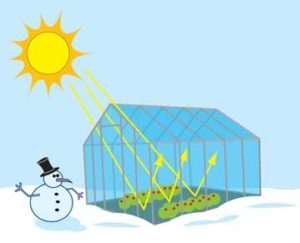
Energy from the sun warms the inside of cars, which you have experienced if you’ve ever gotten into a hot car that was parked in the sun. The process that causes this is basically the same as the process of global warming – and just as undeniable
Global Warming Is As Undeniable As Gravity – Here’s Why
If you’ve ever gotten into a car on a sunny day, you know that global warming is real. The inside of the car will be much hotter than the air outside. This is because light energy from the sun gets into the car, and the interior car surfaces absorb this energy, which heats the car’s seat, dashboard, floor, etc. The car’s roof and windows then trap the heat, and the whole inside of the car gets hotter.
A greenhouse (with walls of glass) or hoop house (with walls of plastic) works on the same principle. Sunlight penetrates the walls, is absorbed by and heats interior
surfaces, and the heat radiated by those surfaces is trapped inside. Even in winter, the greenhouse will warm in the sun and can be used to grow food and flowers.
The earth is warm for the same reason a car interior or greenhouse is. The difference is that the heat-trapping planetary “walls” are made of gases in the earth’s atmosphere. The gases that are best at trapping heat are called “greenhouse gases.”
Without this atmospheric blanket, our planet would be too cold to support life as we know it. Most of the sunlight that hits the earth would just be radiated back into space. So some greenhouse gases are needed to keep earth green and thriving. These are produced by natural forces, and over time fluctuate within limits that have
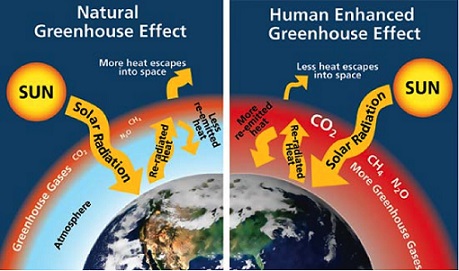
This image from the National Park Service shows how global warming occurs. You can see the thickened blanket of greenhouse gases from human activity.
been compatible with life as we know it.
The problem with human-caused warming is that greenhouse gases are produced by human activities in amounts hugely in excess of historical natural ranges. Thus, the heat-trapping atmospheric blanket lets less heat energy escape back into space, and the planet continues to warm. This results in climate change – an alteration in the patterns of temperature, wind, rainfall, and major weather-related events over the planet.
While humans can deny the existence of this process, this doubt does not impact the real world situation. It’s like denying gravity, another basic law of physics. No matter how much you say it’s not so, pass laws against it, or try to ignore gravity, if you are standing on the earth’s surface and toss a ball into the air, it will come back down. Similarly, if heat radiates up into a thickened layer of greenhouse gases, it will be trapped by the atmosphere and contribute to overheating the planet.
Greenhouse Gases – The Link to What You Eat
Carbon dioxide, the best known and most abundant greenhouse gas, is produced in large part by fossil fuel combustion and deforestation. Both these are related to raising animal for food. Deforestation is frequently motivated by clearing land to
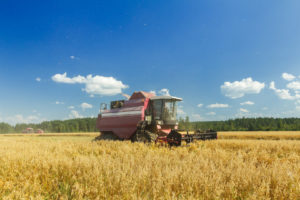
Much energy is needed to power all the farm equipment used to grow food that is fed to livestock. This is a major contributor to global warming.
graze livestock on.
Huge amounts of fossil fuels are needed to power farm equipment used to raise the plant food that is fed to farmed animals, and to power the ships that decimate the ocean’s fish for human consumption.
However, particle for particle, two other greenhouse gases generated in massive amounts by animal agriculture are more powerful. Methane is 25 times more potent than carbon dioxide in holding in heat and raising the earth’s temperature. While there are many sources of methane, the one that is increasing the fastest is agriculture – especially gas that forms in the stomachs of cows and sheep.
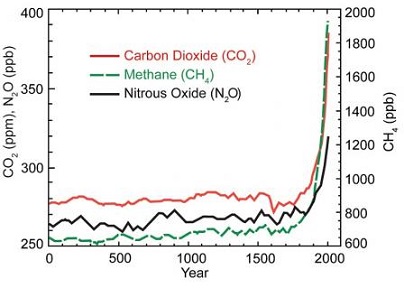
This Environmental Protection Energy chart shows that the amount of powerful greenhouse gases in the atmosphere is climbing relentlessly. Unbiased scientists agree this is caused by human activities, such as energy generation, agriculture, and deforestation.
Nitrous oxide, a greenhouse gas also produced by activities directly linked to animal agriculture, is an even warmer blanket than methane is. Nitrous oxide, particle for particle, is 298 times more potent than carbon dioxide. Most emissions are agricultural, resulting from soil fertilization. A large percentage of crops grown with fertilizer are fed to animals raised for food. In addition, nitrous oxide comes out at the other end; that is, the manure from farmed animals is the origin of significantly more nitrous oxide.
Taking these processes into account, researchers estimate that between 18% and 51% of total global warming results from raising animals for food. More thorough studies tend to find the higher numbers.
The Weather Can Get Colder While the Climate Gets Hotter
Some people are skeptical about climate change because winter can still be very cold. However, this is to be expected. You can better understand this if you think of climate change as climate destabilization. Here’s an example of how the numbers work.
Imagine you live in a place where the high temperature every day is a steady 60 degrees. So 60 degrees is the average high in this location. Now the climate becomes destabilized. Half the days have a high of 65 degrees, and half the days have a high of 55 degrees. The average high (averaging the 65 and the 55) is still 60 degrees, so the location has still not warmed, but some days are colder than they used to be.
In our example, the destabilization continues. Half the days now have a high of 40 degrees, and half the days now have a high of 82 degrees. So some days are considerably colder than they were originally. Yet the average high is now 61 degrees, compared to the original 60 degree average. So this imaginary location is now warmer on average, yet also colder on half the days.
Of course climate destabilization over the surface of our planet is hugely more complex than this. Yet, as his example shows, even numerous chilly days are still compatible with overall warming of earth.
You Can Have a Measurable Impact
The fact that climate change has become a political issue is tragic. This is like making gravity a political issue. Denial only makes the situation more dangerous by reducing the time we have to respond and make a difference.
Here are actions you can take.
- Let politicians know that climate change is real and human caused, and finding a way to slow this process is fundamental to preserving life as we know it on our beautiful planet
- Shrink your own carbon footprint by reducing your consumption of energy and goods
- Most importantly, stop consuming animal foods! This will dramatically slash
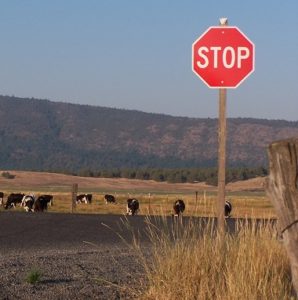
You don’t have to wait for slow and dysfunctional government processes. Now that you understand what is causing climate change, you can take powerful action yourself now. The quickest, most effective step is to stop eating animal foods.
the amount of potent methane and nitrous oxide you contribute to the atmospheric heat blanket, and is the best way to have a major, rapid impact on global warming
If you enjoyed this article, you may want to read about how Dr. Bill Ripple, distinguished professor at Oregon State University, demonstrates the harmful impact of grass fed beef on the planet’s climate and ecosystems.
Intrigued? Now you can use our Whole Foods Blog Finder to target informative, fun postings on whole foods, plant-based diets. Quick information at no cost!
Post written by Janice Stanger, Ph.D. Janice authored The Perfect Formula Diet: How to Lose Weight and Get Healthy Now With Six Kinds of Whole Foods. This book outlines a whole foods, plant-based diet that will dramatically reduce your contribution to climate change.
Tags: Climate change, climate destabilization, global warming, greenhouse gases, whole foods plant-based diet
